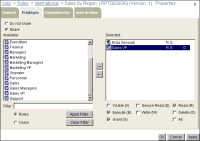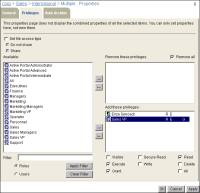Setting privileges on files and folders
The administrator sets file or folder privileges on Properties—Privileges.
Figure 4‑5 shows the privileges on the /Sales folder.
If an item has shared access, where an item can be a file or a folder, the owner can assign or remove privileges on the item. A user who is not the owner of an item can assign or remove privileges on the item if it is shared and the user has grant privilege on the item. The administrator can always assign or remove privileges on an item. By default, all items are shared. If the administrator or owner does not want other users to have access to an item, that individual can make the item private by selecting not to share it. Only the owner and Encyclopedia volume administrator can access a file or folder that is not shared.
The Available list contains either security roles or users, depending on whether you select Roles or Users. For example, in
Figure 4‑5, selecting Roles displays the list of security roles in Available. You can select any of the roles or users in Available and, by choosing the right arrow, move items, one or more at a time, to Selected. In Selected, assign privileges to each user or role by selecting the privileges in the list below Selected.
Figure 4‑5 Viewing Properties—Privileges for a folder
When setting privileges on a single item or multiple items, the manner in which the administrator sets privileges differs, depending on which of the following single or multiple items the administrator is setting privileges:

An existing folder
Add, remove, and replace privileges on the folder and its contents.

A single file or new folder
Add and remove privileges on the item.

Multiple items
Add and remove privileges on two or more items simultaneously.
How to set privileges on an existing folder
1 On Files and Folders, point to the arrow next to a folder and choose Properties, as shown in
Figure 4‑6.
Figure 4‑6 Choosing an existing folder
On Properties, choose Privileges.
2 On Privileges, perform the following tasks:
1 Specify whether the folder is shared or private. By default, files and folders are shared. To make the folder private, select Do not share.
2 To assign privileges to one or more users:
1 Select Users to display the user list in Available.
2 Select one or more users in Available and move the user or users to Selected.
3 With the user or users selected, select privileges from the list of privileges below Selected.
To assign privileges to one or more roles, select Roles to display the roles list in Available. Then assign privileges similarly to the way you assign privileges to one or more users.
3 To set privileges for the contents of a folder, use the selections below the list of privileges as follows:

To set privileges for the folder and contents, including the subfolders and files at that level, select Apply these privilege settings to the contents of the folder. Management Console retains any previously assigned privileges.

To set privileges for the folder and contents, including the subfolders and files at all levels below it, select Recursively include subfolders and their contents. Management Console retains any previously assigned privileges.

To replace the existing privilege settings on the folder and contents and specify new privileges, select Replace existing privilege settings.
For example, as shown in
Figure 4‑7, assign read and write privileges on the
/Sales/International folder to Eriza Senoadi. Then, assign read privilege on the folder to the Sales security role. These privileges also apply to the subfolders and files at all levels below /Sales/International and replace any previously assigned privileges.
Figure 4‑7 Setting privileges on an existing folder
Choose OK.
How to set privileges on a single file or new folder
The tasks for setting privileges on a single file or new folder are the same tasks you perform to set privileges on an existing folder, with the exception that a file or new folder has no contents on which to set privileges.
1 On Files and Folders, choose Create Folder or point to the arrow next to a file and choose Properties, as shown in
Figure 4‑8. The tasks you perform to set privileges on a single file or a new folder are identical.
On Properties, choose Privileges.
Figure 4‑8 Choosing a single file
2 On Privileges, perform the following tasks:
1 Specify whether the file is shared or private by accepting Share or selecting Do not share.
2 Select one or more roles or users in Available and move them to Selected.
3 With the users or roles selected, assign privileges from the list of privileges.
For example, assign read and execute privileges on the Sales by Region BIRT design file to Eriza Senoadi. Then, assign read, execute, and grant privileges on the file to the Sales VP security role, as shown in
Figure 4‑9.
Figure 4‑9 Setting privileges on a single item
Choose OK.
How to set privileges on multiple items
1 On Files and Folders, select the individual items on which you want to set privileges.
Figure 4‑10 shows two files selected. Alternatively, to select all items on the page, select the box next to Name. To select all items in the folder, select Select all items.
Point to Act upon selected items and choose Properties, as shown in
Figure 4‑10.
Figure 4‑10 Selecting two files
On Properties, choose Privileges.
2 On Privileges, perform the following tasks:
1 To specify whether the selected items are private or shared, select Set file access type. Then, select Do not share or Share.
2 To display the list of roles in Available, select Roles. To display the list of users, select Users.
3 To remove privileges from the selected items, move one or more roles or users from Available to Remove these privileges. iHub assigns all privileges to a role or user you move to Remove these privileges. Deselect the privileges that you want the role or user to keep.
4 To add privileges to the selected items, move one or more roles or users from Available to Add these privileges. With the role or user selected, assign privileges from the privileges list.
5 To remove all privileges from the selected items, except privileges you assign in Add these privileges, select Remove all.
For example, assign read and execute privilege on the two selected files to Eriza Senoadi. Then, assign read, execute, and grant privileges on the files to the Sales VP security role. Finally, select Remove all to remove all other privileges on the selected files, as shown in
Figure 4‑11.
Figure 4‑11 Setting privileges on multiple items
Choose OK.







